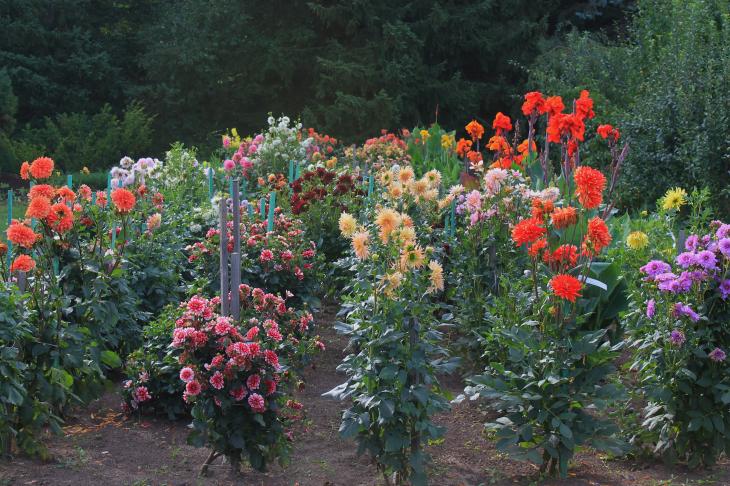|
MAIN PAGE
> Back to contents
Agriculture
Reference:
Nikitina A.D., Mukhametova S.V., Okach M.A.
Dahlias collection in the Botanical garden-institute of VSUT (Yoshkar-Ola)
// Agriculture.
2023. № 1.
P. 14-21.
DOI: 10.7256/2453-8809.2023.1.40923 EDN: CWDGWP URL: https://en.nbpublish.com/library_read_article.php?id=40923
Dahlias collection in the Botanical garden-institute of VSUT (Yoshkar-Ola)
Nikitina Anna Dmitrievna
Student, Department of Landscape Gardening, Botany and Dendrology, Volga State University of Technology
424000, Russia, Republic of Mari El, Yoshkar-Ola, Lenin Square, 3, room 245

|
anyutka08.01@mail.ru
|
|
 |
Mukhametova Svetlana Valer'evna
ORCID: 0000-0001-7892-6450
PhD in Agriculture
Associate Professor at the Department of Garden and Park Design, Botany and Dendrology of Volga State University of Technology
424000, Russia, Mari El Republic , Yoshkar-Ola, Lenin Square, 3, aud. 245

|
MuhametovaSV@volgatech.net
|
|
 |
Other publications by this author
|
|
|
Okach Mariya Aleksandrovna
Teacher at the Department of Garden and Park Design, Botany and Dendrology of Volga State University of Technology
424030, Russia, Mari El Republic, Yoshkar-Ola, Lenin Square, 3, aud. 245

|
OkachMA@volgatech.net
|
|
 |
Other publications by this author
|
|
|
DOI: 10.7256/2453-8809.2023.1.40923
EDN: CWDGWP
Received:
04-06-2023
Published:
16-06-2023
Abstract:
Dahlia Cav. is a beautifully flowering perennial plant from the family Asteraceae Dum. It has storing root tubers that do not survive during the winter in the open ground of central Russia. This crop is characterized by a high variety of colors, shapes and sizes of inflorescences, different plant heights, long-term stable decorative effect from the beginning to the end of the growing season. The purpose of the study is to analyze the Dahlia × cultorum collection in the Botanical Garden-Institute of the Volga State University of Technology (Yoshkar-Ola, Mari El Republic). As of 2021, plants of 32 cultivars were grown in the exposition «Ornamental Herbaceous Plants», each cultivar is represented by 1-5 plants. It is established that the available cultivars belong to 6 classes according to the structure of inflorescences, the largest number of them belong to the class of Decorative and Semi-Cactus (12 and 8 names, respectively). According to the color of the inflorescences, the largest number of cultivars has bicolor inflorescences. The small-flowered cultivars dominated according to the inflorescences size. In general, most cultivars with large and medium-sized inflorescences have a decrease in their size. We can replenish the collection with varieties from the smallest represented classes, as well as the missing 6 classes. The results can be used in the practice of settlements landscaping of the Mari El Republic and nearby regions.
Keywords:
Dahlia cultorum, inflorescence shape, inflorescence size, inflorescence color, plant cultivation, collection analysis, variety distribution, classification, exposition, botanical garden
This article is automatically translated.
You can find original text of the article here.
Introduction. Dahlias are perennial plants from the family of compound flowers (Asteraceae Dum.). The dahlia genus (Dahlia Cav.) unites 27 species distributed in the mountainous regions of Central America. Cultural dahlias are represented by varieties of hybrid origin, combined into one species – Dahlia cultorum (Dahlia ? cultorum Thorsr. et Reis.) [1]. Also in the literature, the union of all hybrid varieties into the species Dahlia variabilis Desf is used. [2]. Dahlias were brought to Europe in the 1700s by Spanish travelers [3]. Dahlia plants were named in honor of the Swedish botanist A. Dahl, dahlia – in honor of Professor of the St. Petersburg Academy of Sciences Johann Gottlieb Georgi. Dahlias appeared in Russia in the middle of the 18th century. They were first shown at the flower show in Moscow in 1844 [4]. A characteristic feature of dahlias are storing root tubers, which do not winter in the open ground of central Russia. The height of the plants varies from 30 to 150 cm and above, the diameter of the inflorescences is from 3 to 30 cm, and a very high variety of color of the inflorescences is also characteristic of this culture. Depending on the degree of terry and the shape of the tongue flowers, all varieties are divided into garden groups. Currently, the world assortment of dahlias is about 18 thousand cultivars. The lifespan of the variety (with some exceptions) is 15-20 years, as a result of which there is a constant process of renewal [5]. The international classification includes 10 groups of dahlias [6], The National Dahlia Society of England identifies 15 groups [7, 8]. In Russian literature, they adhere to the classification of 1983, developed by the Main Botanical Garden of the USSR Academy of Sciences (in the reference edition "Flower-ornamental plants" edited by V.N. Bylov) and includes 12 classes: single-row, anemone-shaped, collared, peony-shaped, straight cactus, cactus with curved petals, spherical, pompom, decorative, nymphal, semi-cactus, mixed [4, 9]. The main advantage of representatives of the genus Dahlia is the abundance and continuity of flowering from the onset of the flowering phase (in Central Russia – from the beginning of August) to frost, long–term stable decorative effect from the beginning to the end of the growing season. Dahlias are distinguished by a variety of shapes, sizes and colors, different plant heights and high reproduction rates [10]. The flowering dates of dahlias vary in different years depending on weather conditions, but the sequence of flowering remains unchanged [2]. In addition to widespread use in landscaping, dahlia varieties are used in floristry, as a cutting crop [3]. In world practice, work on the breeding of new varieties with the ability to preserve the decorative effect of cut flowers for a long time is relevant [11]. In addition, dahlias are used for the pharmaceutical, cosmetic and food industries, as well as as raw materials for the production of dyes. Root tubers and flowers are used for medicinal purposes [3]. Dahlia root tubers contain inulin, tannins, essential oils, organic acids, amino acids, ascorbic acid, and are also sources of macro- and microelements, especially calcium and manganese [12]. In the USA and some European countries, root tubers of certain types of dahlias are used as a source of industrial production of inulin [12, 13, 14]. There are studies on the possibility of food use of dahlia flowers. Lingual flowers contain biologically active compounds and have an antioxidant ability. The petals of pink and purple flowers contain more protein, crude fiber, vitamin C, phenols and flavonoids, while yellow ones show a higher antioxidant capacity [15]. Planting material can be purchased in large chain and small commercial specialty stores, as well as on the Internet, and from the hands of individuals. Retargeting is present everywhere, but especially on a large scale – in large chain stores. In addition, in online hypermarkets, the planting material has signs of degeneration, starting from the first year of cultivation, expressed in the loss of the characteristic terry of the flower variety. Small specialized outlets are more responsible for the image and quality of the sold material, choosing proven manufacturers and suppliers [16]. Dahlias are demanding of soil moisture, which increases with increasing ambient temperature, as well as soil fertility, they need structural, slightly acidic and neutral soils [4]. Fertilization has a positive effect on the size and weight of inflorescences, the number of inflorescences on the plant [17]. For the qualitative formation of tubers, it is necessary to observe the agrotechnics of cultivation. Abundant flowering is promoted by foliar feeding techniques on leaves with growth stimulants (for example, yantarin) and carbamide. In addition, it contributes to a longer flowering and preservation of freshness in the cut [16]. When growing dahlias, it should be borne in mind that they are susceptible to infection with a specific virus – Dahlia mosaic virus (Dahlia mosaic virus) and non-specific viruses, such as tobacco streak virus (Tobacco streak virus), Tomato spotted wilt virus (Tomato spotted wilt virus), cucumber mosaic virus (Cucumber mosaic virus) and X-Potato virus (Potato X virus) [1]. In many settlements of the temperate climate of Russia, dahlias are distributed mainly in private gardens, while in world practice they are widely used to create rabatok, borders, group plantings, in flower beds, in bouquets, and also as a container culture. This is due to the lack of a scientifically-based zonal assortment of dahlias, as well as effective methods of storing planting material in winter [18]. Many botanical gardens collect collections of the Dahlia genus. A limitation in the formation of the collection is the need to preserve the root tubers of dahlias in winter and the labor cost of agrotechnical measures. Researchers note [10] that one of the tasks of maintaining a collection of dahlias is to preserve varieties of domestic breeding, which have been noticeably decreasing in the last few years, since few people are currently engaged in dahlia breeding in our country.
The purpose of the study is to analyze the collection of dahlias of the Cultural Botanical Garden-Institute of the State Technical University (Yoshkar-Ola, Republic of Mari El). The principle of forming a collection of cultural dahlias in BSI PSTU is based on attracting varieties with the original color and shape of the inflorescence, as well as varieties from new garden groups. As of 2021, 32 varieties of plants were grown in the exhibition "Ornamental Herbaceous Plants", each variety is represented by 1-5 copies. (figure 1). 
Drawing – A general view of the dahlia in the exhibition Research methodology. The study was conducted in 2021-2022. Reconciliation of the names and description of the characteristics of the varieties was carried out on the basis of the website www.dahlie.net [19]. The distribution of varieties by classes was carried out according to the national classification [4, 9], according to the size of inflorescences – according to the classification of the American Dahlia Society [20, 21]. The results of the study. The distribution of the 32 varieties of dahlia available in the collection by the shape of inflorescences into 12 classes according to the national classification showed that there are varieties of only 6 classes (Figure 2). The largest number of varieties of the collection, 12 names, 38%, belongs to the decorative class. A slightly smaller number of semi–cactus dahlias are represented - 8 varieties, 25%. The classes of nymphal, spherical, cactus with curved petals and straight cactus include 3 varieties, which is 9% each. You can replenish the collection with varieties from the smallest represented classes, as well as the missing 6 classes (single-row, anemone-shaped, collared, peony-shaped, pompom, mixed). 
Figure 2 – The ratio of varieties of dahlias cultivated in the form of inflorescence Based on the color of the inflorescences, dahlias varieties were divided into 9 groups (Figure 3). The largest group – 10 names, 31% of the studied varieties – are varieties with bicolor inflorescences. White color has 6 varieties (19%), red – 5 (16%), yellow – 4 (13%). Varieties with orange and lilac inflorescences are represented in the collection by 2 names (6% each). Dahlias with pink, dark red and purple inflorescences are represented by single varieties, which is 3% of the total number of varieties. 
Figure 3 – Distribution of cultivars of dahlias by color of inflorescences According to the size of the inflorescences, dahlias are divided into 5 groups: giant (more than 25 cm), large (20-25 cm), medium (15-20 cm), small (10-15 cm) and miniature (5-10 cm) [20, 21]. It is known that the difference in the diameter of the inflorescence of the same variety in different climatic conditions with different agricultural techniques can be two or more times, due to different conditions of humidification, solar radiation, temperatures and soil nutrition [22]. The distribution of varieties according to these groups (Figure 4) showed the predominance of small–flowered varieties in the collection (19 according to literature data, 18 - in fact). Large-flowered varieties ('Caf? au Lait', 'Mingus Joshua', 'Polly Bergen', 'Winkie Colonel') in the conditions of the botanical garden had medium-sized inflorescences. Among the varieties with medium inflorescences, only 'Zelta Zvaigznite' retains its size, in other varieties 'Black Narcissus', 'Caribbean Fantasy', 'White Star', 'Snow-Covered Rus', 'Zhuravushka', a decrease in inflorescences to small ones was noted. The number of dahlias with miniature inflorescences in the collection amounted to 9 names, while according to literary data only 'Hawaii', 'Kochelsee', 'Princesse Gracia' have this size of inflorescences. Thus, varieties with large and medium-sized inflorescences were characterized by a stronger decrease in their size: all 4 large-flowered varieties had medium-sized inflorescences, 5 varieties with medium inflorescences became small-flowered. 
Figure 4 – The ratio of cultivars of dahlias by the size of inflorescences
Conclusion. Thus, the composition of the collection fund of the Dahlia genus of the Botanical Garden-Institute of PSTU is analyzed. The available 32 varieties belong to 6 classes according to the structure of inflorescences, the largest number of them belong to the class of decorative and semi-cactus. According to the color of the inflorescences, the largest number of varieties have bicolor inflorescences. The size of the inflorescences is dominated by small-flowered varieties. In general, most varieties with large and medium-sized inflorescences have a decrease in their size. You can replenish the collection with varieties from the most numerically represented classes, as well as the missing 6 classes: single-row, anemone-shaped, collared, peony-shaped, pompom, mixed. According to the color of the inflorescences, it is worth attracting varieties with orange, lilac, pink, dark red and purple inflorescences. The results can be used in the practice of landscaping settlements of the Republic of Mari El and nearby regions.
References
1. Nesmelov I.B., Tolkach V. Ph., & Babikova A.V. (2015). Dahlia × cultorum (Thorsr. et Reis): Problems when used in landscaping. In: Protection and efficient usage of forest resources. Materials of the VIII International Forum (Blagoveshchensk, 8 – 10 June 2015). Part 2, 91–95. Blagoveshchensk: Far Eastern state agricultural university. In Russian.
2. Mironova L.N., & Denisova S.G. (2016). Dahlias in the South Urals: Biological features and prospects for the use. Proceedings of the RAS Ufa scientific centre, 2, 48–53. In Russian.
3. Kiryushina N.А., Orlova Е.Е. (2021). Assortment of border dahlias for use in landscaping in the Moscow region. Bulletin of Landscape Architecture, 26, 45–48. In Russian.
4. Sukhanov V.М. (1991). Dahlias. Moscow: Agropromizdat. In Russian.
5. Korevko I.A. (2018). Dahlia in landscaping. In: State and Prospects for the Development of Green Construction in the Republic of Belarus: Theses of the Republican scientific and practical seminar (Minsk, Belarus, April 26-27, 2018), 94–96. Minsk: Medisont. In Russian.
6. Lyabik О. (2008). Dahlias. Moscow: TID Continent Press, Continental Book. In Russian.
7. The National Dahlia Society [Electronic resource]. Retrieved from: https://www.dahlia-nds.co.uk/
8. Thakur P., Shah A.H., Adhikari Y., Kumar M., & Verma S. (2022). Dahlia cultivation in India and abroad: A Review. International Journal of Plant & Soil Science, 34(19), 240–251. doi:10.9734/ijpss/2022/v34i1931108
9. Dahlia. Fam. Compositae. In: Encyclopedia of ornamental garden plants [Electronic resource]. Retrieved from http://flower.onego.ru/lukov/dahlia.html
10. Savelyeva G.A., & Bondorina I.A. (2019). The results of garden Dahlia (Dahlia cav.) introduction in the Main botanical garden of the Russian academy of sciences for the years, 2009–2018. In: Scientific support for sustainable development of fruit growing and ornamental gardening: Materials from the International scientific and practical conference, dedicated to the 125th anniversary of the foundation of the Russian Research Institute of Floriculture and Subtropical Crops and to the 85th anniversary of the Foundation of the Botanical Garden "The Tree of Friendship" (Sochi, September 23–27, 2019), 318–324. Sochi: RRIFSC.
11. Onozaki T., & Azuma M. (2019). Breeding for long vase life in Dahlia (Dahlia variabilis) cut flowers. The Horticulture Journal, 88(4), 521–534. doi:10.2503/hortj.UTD-091
12. Denisova S.G., Mironova L.N., & Pupykina K.А. (2015). The biochemical study and perspective of using representatives of the genus Dahlia Cav. Chemistry of plant raw material, 2, 77–83. doi:10.14258/jcprm.201502563
13. Mironova L.N., Denisova S.G., & Pupykina K.А. (2016). Dahlias South Ural: Successful introduction, biology, chemical composition. Proceedings of Voronezh State University. Series: Chemistry. Biology. Pharmacy, 4, 59–66. In Russian.
14. Putri V.D., Yanti S., Dyna F., Saryono S., & Ismawati I. (2022). The extraction and characterization of inulin from dahlia bulbs (Dahlia variabilis). In: The international conference on advanced material and technology (ICAMT): AIP Conference Proceedings (14–16 December 2021), 2708(1), 030001. doi:10.1063/5.0122564
15. Martínez-Damián M.T., Mejía-Muñoz J.M., Colinas-León M.T., Hernández-Epigmenio F., & Cruz-Alvarez O. (2021). Nutritional value, bioactive compounds and capacity antioxidant in edible flowers of dahlia. Acta Scientiarum Polonorum Hortorum Cultus, 20(5), 63–72. doi:10.24326/asphc.2021.5.6
16. Volkova S.N., Sivak E.E., Morozova V.V., Pashkova M.I., Gerasimova V.V., & Zhernokleeva A.I. (2021). Review of modern varieties of dahlias for commercial breeding on household plots. Regional Bulletin, 5, 37–41.
17. Kumar N., Prasad V.M., & Yadav N.P. (2019). Effect of chemical fertilizers and bio fertilizers on flower yield, tuberous root yield and quality parameter on dahlia (Dahlia variabilis L.) cv. Kenya orange. Journal of Pharmacognosy and Phytochemistry, 8(4), 2265–2267.
18. Denisova S.G., & Mironova L.N. (2007). Introduction Dahlia L. in Bashkortostan. Problems of botany in South Siberia and Mongolia, 6, 246–247.
19. Dahlienverzeichnis [Electronic resource]. Retrieved from http://www.dahlie.net/de/index.html
20. American Dahlia Society [Electronic resource]. Retrieved from https://www.dahlia.org/
21. Varieties of dahlias with photos and descriptions [Electronic resource]. Retrieved from https://fermilon.ru/tsvety/mnogoletniki/sorta-georginov-s-foto-i-opisaniem.html
22. Dahlias (1984). Edited by N.A. Bazilevskaya. Moscow: MSU Publishing House
Link to this article
You can simply select and copy link from below text field.
|
|



